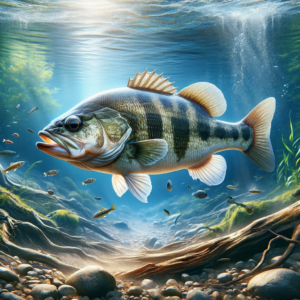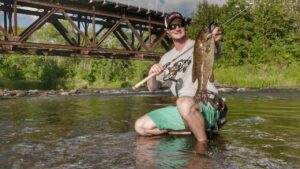Have you ever wondered how to find smallmouth bass in a river? These elusive and powerful fish can be a challenge to locate, but with the right tips and techniques, you can increase your chances of success. In this article, we will discuss the various strategies you can use to find smallmouth bass in a river. Whether you are an experienced angler or just starting out, these tips will help you improve your fishing skills and increase your catch rate.
Rivers offer a diverse and dynamic environment for smallmouth bass, making them an exciting and rewarding species to target. To find smallmouth bass in a river, it’s important to understand their behavior and habitat preferences. Smallmouth bass are often found near structure such as rocks, fallen trees, or river bends. These areas provide cover and ambush points for the fish, allowing them to hide and wait for prey to pass by. By targeting these structures, you can increase your chances of finding smallmouth bass.
Additionally, smallmouth bass are known to prefer certain types of water conditions. They are typically found in clear, cool, and oxygen-rich waters. Look for areas with moderate current flow, as this provides the ideal conditions for smallmouth bass to thrive. The presence of aquatic vegetation and baitfish can also indicate the presence of smallmouth bass. By paying attention to these factors and scouting the river before you start fishing, you can narrow down your search and increase your chances of finding smallmouth bass.
In the next article, we will delve deeper into specific techniques and lures that can be effective in catching smallmouth bass in a river. From fly fishing to casting crankbaits, we will explore various methods that have proven successful. By applying these tips and techniques, you will be well-equipped to find and catch smallmouth bass in a river. So, stay tuned and get ready to enhance your angling skills in pursuit of this exciting species.
Understanding Smallmouth Bass
Smallmouth bass (Micropterus dolomieu) are highly sought after game fish known for their strong fighting ability and aggressive nature. They are native to North America and are widely distributed throughout the continent, particularly in rivers and streams. In this article, you will learn about the characteristics, habitat preferences, and fishing techniques for smallmouth bass in a river.
Characteristics of Smallmouth Bass
Smallmouth bass can be easily identified by their bronze or olive green coloration, with dark vertical bars on their sides. They have a slightly elongated body and a large mouth filled with sharp teeth. On average, they measure between 12 and 15 inches in length and weigh around 2 to 3 pounds. However, larger specimens can reach lengths of up to 24 inches and weigh over 5 pounds.
Habitat Preferences of Smallmouth Bass
Smallmouth bass are primarily found in clear, flowing rivers and streams. They prefer cooler water temperatures ranging from 68 to 74 degrees Fahrenheit. As ambush predators, they are often found near submerged structures such as rocks, logs, and weed beds, which provide them with cover and opportunities to ambush unsuspecting prey.
Identifying Suitable River Locations
To find smallmouth bass in a river, it is important to pay attention to their preferred habitat. Here are some tips on how to identify suitable locations:
Study the River Geography
Familiarize yourself with the river’s geography by studying maps or using online resources. Look for areas with rocky or gravel bottoms, as smallmouth bass are known to congregate in these areas. Also, identify any river bends or confluences where the current slows down, creating ideal feeding grounds for smallmouth bass.
Look for Deep Pools
Deep pools are attractive to smallmouth bass as they provide shelter from strong currents and access to cooler water. Look for areas where the river deepens significantly, usually near bends or behind large boulders. These pools often hold trophy-sized smallmouth bass.
Search for Submerged Structures
Smallmouth bass are known to congregate around submerged structures such as rocks, logs, and fallen trees. These structures provide both cover and a natural feeding ground for smallmouth bass. Cast your lures or bait near these structures and allow them to sink to the desired depth before retrieving.
Best Fishing Techniques
Once you have located suitable river locations, it’s time to employ the best fishing techniques for smallmouth bass. Here are some tried and tested methods:
Casting and Retrieving Using Artificial Lures
This technique involves casting artificial lures, such as crankbaits, jerkbaits, or spinnerbaits, and retrieving them with a steady or erratic motion. Experiment with different retrieval speeds and depths until you find a pattern that entices smallmouth bass to strike. Remember to vary your retrieve to mimic the movement of prey.
Fly Fishing for Smallmouth Bass
Fly fishing for smallmouth bass can be highly effective, especially in river environments. Use streamer patterns that imitate baitfish or crayfish and present your flies using a combination of casting and stripping motions. Look for areas with slow currents or eddies where smallmouth bass are likely to hold.
Drift Fishing with Live Bait
Drift fishing with live bait is another productive technique for catching smallmouth bass in a river. Use live bait such as nightcrawlers, minnows, or crayfish and rig them on a sliding sinker rig. Cast your baited rig upstream and allow it to drift naturally with the current. Monitor your line for any signs of a strike and be prepared to set the hook.
Using the Right Equipment
Using the right equipment is essential for a successful smallmouth bass fishing experience. Here are some considerations when selecting your gear:
Selecting the Ideal Fishing Rod
When targeting smallmouth bass, opt for a medium to medium-heavy spinning or baitcasting rod. A rod with a length between 6 and 7 feet provides the right balance of casting accuracy and power to handle smallmouth bass. Make sure the rod has a sensitive tip to detect subtle strikes and a strong backbone to control the fish during the fight.
Choosing the Appropriate Fishing Line
For smallmouth bass fishing in a river, a monofilament or fluorocarbon fishing line with a test strength between 6 and 12 pounds is suitable. Monofilament lines offer good abrasion resistance and are more forgiving when casting. Fluorocarbon lines, on the other hand, are virtually invisible underwater and provide excellent sensitivity.
Picking the Right Lures or Baits
Select lures or baits that mimic the natural forage of smallmouth bass in the river. Crankbaits, jerkbaits, spinnerbaits, and soft plastic creatures or tubes are popular choices. Experiment with different colors and sizes to match the prevailing conditions and the smallmouth bass’s feeding preferences.
Environmental Factors
Understanding the environmental factors that influence smallmouth bass behavior is vital for successful fishing. Here are some factors to consider:
Water Temperature and Seasonal Patterns
Water temperature plays a significant role in smallmouth bass activity. They are most active in the spring and fall when water temperatures range between 55 and 65 degrees Fahrenheit. Monitor the water temperature throughout the day and adjust your fishing techniques accordingly. In colder water, slow down your presentations, while in warmer water, increase your retrieval speed for a more aggressive response.
Considering Water Clarity
Smallmouth bass prefer clear water with good visibility. In murky or stained water conditions, they rely more on their lateral line system to detect prey. Use lures or baits with vibration or rattling features to attract their attention. In clear water, opt for more natural-looking lures and finesse presentations.
Assessing Current Speed and Direction
The current plays a significant role in smallmouth bass feeding behavior. They often hold behind rocks or other structures where the current is slower, waiting for prey to be swept into their path. Pay attention to the speed and direction of the current and target areas where smallmouth bass can easily ambush their prey.
Observing Fish Behavior
To increase your chances of catching smallmouth bass, it is essential to observe their behavior. Here are some behaviors to learn and recognize:
Learning How Smallmouth Bass Feed
Smallmouth bass are opportunistic predators and feed on a wide range of prey, including minnows, crayfish, insects, and even smaller fish. Observe their feeding patterns and the type of prey they are targeting. This knowledge will help you select the right lures or baits and present them in a manner that triggers a strike.
Recognizing Spawning Habits
Understanding the spawning habits of smallmouth bass is crucial for conservation purposes. During the spring months, smallmouth bass migrate to shallow gravel or rocky areas to spawn. Avoid fishing in these areas during the spawning period to protect the vulnerable eggs and fry. Consult local fishing regulations for specific guidelines on the spawning season in your area.
Implementing Effective Fishing Strategies
To increase your chances of success, implement effective fishing strategies that target the specific behaviors of smallmouth bass. Here are some strategies to consider:
Using Stealth and Approaching Quietly
Smallmouth bass are highly sensitive to disturbances in their environment. Approach your fishing area quietly, preferably by wading or using a kayak or canoe. Keep noise to a minimum and avoid making sudden movements that may startle the fish. By being stealthy, you increase the chances of getting close to smallmouth bass without spooking them.
Varying Your Retrieve Speed and Depth
To trigger a strike, vary your retrieve speed and depth when using artificial lures. Experiment with different combinations until you find a technique that triggers a reaction from smallmouth bass. Sometimes they prefer a slow and steady retrieve, while other times they are more likely to strike at a fast-moving lure. Similarly, adjust your lure’s depth by using different sink rates or adding weight to your rig.
Utilizing Topwater Baits during Low Light Conditions
Smallmouth bass are notorious for their aggressive nature when it comes to topwater strikes. During low light conditions, such as early morning or late evening, switch to topwater baits such as poppers, frogs, or buzzbaits. These lures create commotion on the water’s surface, imitating natural prey and attracting the attention of smallmouth bass.
Safety and Conservation
As responsible anglers, it is crucial to prioritize safety and conservation when fishing for smallmouth bass in a river. Here are some guidelines to follow:
Observe Fishing Regulations and Limits
Before fishing, familiarize yourself with the fishing regulations and limits in your area. Follow catch-and-release practices whenever possible, especially for larger-sized smallmouth bass. This ensures the sustainability of the fishery and allows future generations to enjoy the thrill of catching smallmouth bass.
Handle and Release Smallmouth Bass Properly
When handling smallmouth bass, wet your hands before touching them to minimize damage to their protective slime coating. Support the fish’s belly with one hand while gently removing the hook with the other. Avoid squeezing or excessively handling the fish, as this can cause internal injuries. Release the fish quickly and carefully back into the water, ensuring it has regained its strength before swimming away.
Respect the River Environment
Treat the river environment with respect by properly disposing of any trash or litter. Avoid damaging natural vegetation or disturbing wildlife. Whenever possible, pack out any trash or debris you encounter, even if it is not yours. By practicing Leave No Trace principles, you help preserve the natural beauty of the river for future generations.
Seeking Local Knowledge
To improve your fishing skills and knowledge of smallmouth bass in a river, seek out local expertise. Here are some ways to gain valuable insights:
Consulting Experienced Anglers
Experienced anglers who regularly fish for smallmouth bass in the same river can provide valuable information and tips. Strike up conversations with local anglers at the fishing spot or join online forums and communities to connect with like-minded individuals. Their knowledge and guidance can significantly enhance your fishing experience.
Joining Fishing Clubs or Online Communities
Fishing clubs and online communities dedicated to smallmouth bass fishing can provide a wealth of information and resources. Participate in club events, workshops, or forums to learn from experienced anglers and share your own experiences. Online communities also offer a platform to ask questions, seek advice, and connect with anglers from around the world.
Conclusion
Finding smallmouth bass in a river requires a combination of knowledge, skill, and patience. By understanding the characteristics and habitat preferences of smallmouth bass, using the right equipment and techniques, and considering environmental factors, you can significantly increase your chances of success. Practice ethical fishing practices, respect the river environment, and seek local knowledge to further enhance your fishing experience. Now, armed with these tips and techniques, it’s time to hit the river and enjoy the thrill of catching smallmouth bass.




